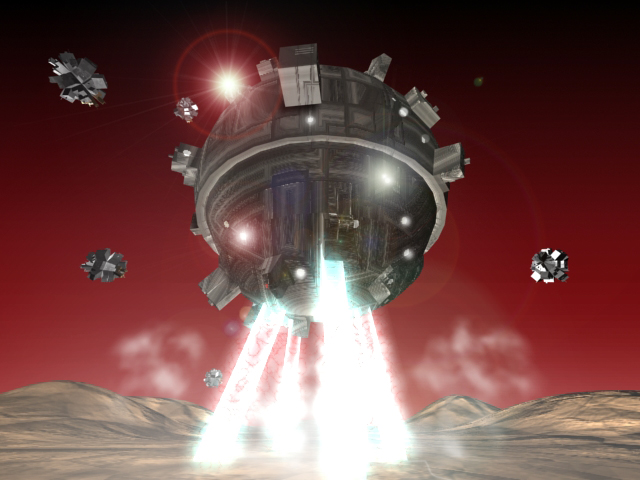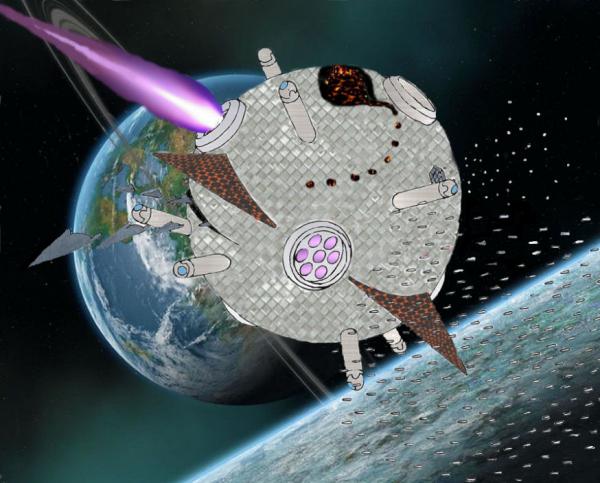BY LETTER
Autowar
Technology > Technology Type or Material > Drytech/Hylotech
Technology > Technology Levels > High Tech / Hitech
Technology > Technology Type or Material > Nanotech
Technology > Application > Weapons > Space-Based Weapons
Culture and Society > Politics & Government > Warfare
Autowars are a type of neumann-capable subsophont warships, which utilize their on-board resources to rapidly reconfigure according to prevailing battlefield conditions, goals, and enemy threats. The controlling intelligence of an autowar may be anything from a subsophont vot to a dedicated, non-sentient S1 hyperturing, up to a S3 non-sophont distributed intelligence formed by the combined resources of an entire autowar swarm. Rather than being generalists that attempt to adequately adapt to different enemy capabilities or different situational needs, these sentient war machines instead reformat their substrate and alter their tactics on the fly to produce several 'classes' of specialist warships, each tailor-made for a specific threat, task, or strategy. Although this article could not possibly encompass the vast array of designs and sub-specializations autowars are known for, there are an array of abilities and basic design concepts that can be said to exist in every autowar's warchive or design template. Technology > Technology Levels > High Tech / Hitech
Technology > Technology Type or Material > Nanotech
Technology > Application > Weapons > Space-Based Weapons
Culture and Society > Politics & Government > Warfare
Autowars have been utilized by most recognized interstellar polities and empires, and rogue populations can be found in the Outer Volumes, often becoming animin-like entities with little in common with the rest of the Terragen Sphere..
A great deal of the success of the autowar as implemented during conflict can be directly attributed to their unrivaled flexibility. Each autowar has an interior filled with feedstock, modular multi-purpose nanofactories, and an extensive, if abridged, warchive. The specific makeup and number of autowar swarms present in a location might vary on a daily basis, as they reconfigure, grow, split into smaller units, or combine into larger units. A basic autowar will be preloaded with both energy and projectile-based weapon systems, such as multi-gigawatt x-ray or UV lasers , torch missiles, and dumbfire railguns for example. Torch missiles have powerful reaction drives allowing them to rapidly close with an enemy several light seconds away, before detonating an amat-core nuclear device to 'boost' an on-board x-ray laser system.
 Image from Steve Bowers | |
| Wandering, rogue autowars are an unwelcome visitor to any civilised system | |
Most but not all autowars are designed to be deployed on inter-planetary scales. Conversion drive and fusion-pulse propulsion systems are the most commonly utilized propulsion methods. If necessary, they can 'grow' interstellar-capable drive systems for redeployment. Once deployed to a target system, typically reconfigure their drive systems to types more appropriate to interplanetary travel and fleet engagements. The most commonly developed drive system is a series of conversion drive-ramjet hybrids or beam-core plasma rockets, coupled with magsail devices for interstellar travel. Once in-system, these may be retained, or reconfigured to various fusion drives with greater maneuverability and alternate fuel requirements. Autowars in their unspecialized state tend to resemble a conversion-drive ramjet-equipped warship, heavily armed and armored, designed to be capable of entering a heavily defended system and starting up an industrial based for future operations.
The smallest forms of specialists within an autowar swarm tend to used as escorts, with limited weaponry but a great deal of maneuverability. These autowars will usually employ UV or X-ray lasers for both offense and point-defense, and carry torch missiles. Some might utilize Orion-style nuclear pulse drives, which can also be used as a weapon system if needed. They may also employ swarms of their own, such as aerospace drone fighters, vacuum-capable khaki goo swarms, or sensory/surveillance satellites. These autowars may be physically small, less than a hundred meters along their longest axis, but still quite massive, especially when equipped with magmatter conversion drives and weaponry.
The largest form, or specialist, in a autowar swarm is a mobile manufacturing base. This sub-class specializes in cannibalizing enemy resources such as disabled ships, enemy habs, or damaged/destroyed friendly units. These autowars fulfill that role, using scavenged resources to produce new autowars, fuel/propellant, munitions for weapons, or hardened infrastructure for allied forces. These autowars tend to be a dozen or so kilometers along each axis, and are not normally exposed to direct conflict as there size and lack of maneuverability makes them easier targets.
Most autowars in a swarm tend to fall somewhere between these two extremes, massing several thousand tons and are only a few hundred meters along their longest axis. Various weapons ranging from S0 designed lasers, S2 designed neutral particle beam turrets, magmatter-boosted relativistic mass drivers, or Q-mirror annihilation munitions are all possible configurations for these units. Few autowars rely entirely upon one type of weapon, and usually host guided missiles alongside their laser turrets. Offensive nano-swarms and sporetech-based infiltration weapons are also widely used by these vessels.
Sporetech swarms utilized be autowars can perform a variety of functions, from forming war factories that build more autowars, to active denial systems that cannibalize surrounding material to build allied armies and invade local habitats. The typical spore-seed is smaller than a human hair, and houses a condensed warchive, limited feedstock, a nanoprocessor, a battery and solar power system, plasma-sail or mag-sail based space propulsion, fullerene-based cilia for atmospheric or ground based propulsion, and limited sensory devices. Individually these seeds cannot accomplish much more than corrupting a single autofab, or converting a single local plant and or animal into a cyborized bio-weapons. Given sufficient time, these spores will replicate, allowing them to gain control of large areas and control the local infrastructure. When used in vast quantities however, they can convert entire biomes or habitats into allied weapons platforms and war factories that produce drones, munitions, or more autowars.
 Image from Juan Ochoa |
Related Articles
Appears in Topics
Development Notes
Text by Tengu459 (2018)
from an original concept by Bill White, modified by M. Alan Kazlev
Initially published on 03 November 2001.
from an original concept by Bill White, modified by M. Alan Kazlev
Initially published on 03 November 2001.







